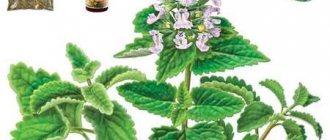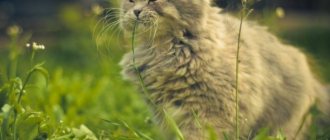The lemon catnip plant, or catnip, is a herbaceous plant belonging to the Lamiaceae family. The habitat of catnip is the entire European part of Russia. Catnip can be found in meadows and forests, and can also be seen in wastelands. The peculiarity of the plant is the presence of a pleasant aroma, reminiscent of a mixture of essential rose and lemon oil.
For cats, the smell of catnip is very pleasant. Sensing the smell of the plant, cats begin to behave very actively, rubbing against the plant, sniffing it and trying to eat it. Noticing a similar effect of the plant on the behavior of the animal, people began to grow catnip at home, as well as purchase dried bags of mint to correct the behavior of their pets.
Content
1. About the beneficial properties of the plant 2. Catnip - what is it? 3. Can a cat have catnip 4. Is peppermint dangerous 5. How to use peppermint for cats 6. Peppermint as a means of education 7. For whom is mint dangerous?
Many pet owners know about cats’ strange love for the smell of mint, but few people think about whether cats can eat mint. It is interesting to observe how strangely pets behave when they smell the scent of weed. However, is it harmful to animal health?
How to use correctly
Catnip can be used in a variety of situations:
- the pet exhibits aggressive behavior;
- too playful and runs around the apartment, knocking down everything in its path;
- you need to accustom your pet to the tray;
- the cat and the owner face a long or difficult journey;
- the cat is lethargic or passive;
- a stomach spasm occurred;
- the pet refuses to eat.
Catnip is useful for giving to cats infected with helminths. This plant has a pronounced anthelmintic effect. The catnip itself can be used both fresh and dried, while all its beneficial properties are preserved.
About the beneficial properties of the plant
More than 25 species of plants from the Lamiaceae family are called mint. The main difference is the characteristic aroma, which provides a high menthol content in the plant.
People have long known about the beneficial properties of the plant and have been using the plant in medicine, cooking and other areas of life since ancient times. In Ancient Greece, mint was used to make refreshing perfumes, and in Ancient Rome it was used as a good breath freshener.
The beneficial properties of mint are due to the composition of the plant. It contains tannins and flavonoids, phytoncides, vitamins - including provitamin A (carotene) and ascorbic acid (vitamin C), essential oils, microelements necessary for a living organism - calcium, potassium, iron, magnesium. Peppermint is used in traditional and folk medicine. It is used as an analgesic, vasodilator, tonic and sedative. In addition, the plant has disinfectant, choleretic properties, and has a positive effect on the functions of the gastrointestinal tract.
Mint is included in various medications - ointments, tinctures, tablets. Medicines are used in the treatment of many diseases - headaches, insomnia, upper respiratory tract diseases, nervous pathologies, etc.
Description of the plant
Lemon catnip grows in Central, Eastern and Western Europe, East Asia, western Siberia and the Caucasus.
In appearance, the plant is almost no different from ordinary mint. But catnip contains nepetalactone, and peppermint contains menthol. It is for this reason that these plants have different smells. The aroma of catnip contains lemon notes.
The leaves of the plant are light green in the shape of a heart, sometimes they may contain splashes of white or pink. The flowers are small, collected in a brush. They can be white, pink or purple. Catnip stems are long. They spread along the ground and intertwine with each other, forming dense thickets. Today there are about 200 species of this plant.
Cats love to spend time in catnip thickets. As a rule, in such places you can see more than a dozen animals at once. Catnip exudes an aroma that has an effect on them similar to that of valerian. Animals seem to fall into euphoria. At the same time, they can behave very strangely.
Catnip - what is it?
Peppermint is commonly found in garden plots; it is used in medicine and cooking. In hot weather, tea with mint refreshes and tones, in case of a cold it will warm you up and relieve fever. But our pets go crazy for another plant called catnip.
The name of this type of mint did not appear by chance. In Ancient Egypt, the plant was dedicated to the goddess Bast; cats living at temples dedicated to her enjoyed feasting on the fragrant herb.
Catnip - catnip - contains a special substance that attracts cats. This essential oil is nepetalactone. It has a rich aroma reminiscent of lemon. What this is connected with is unknown to science, but nepetalactone acts on cats as a pheromone. Excitation occurs in the part of the brain where the center responsible for sexual behavior is located. Therefore, the reaction of cats to mint is similar to behavior during sexual heat.
Moreover, the breed does not matter - addiction operates at the genetic level, and a spoiled domestic purr experiences the same euphoria as a wild panther that encounters a bush of a plant in nature. Fortunately, the effect of the essential oil does not last long, and after 15-20 minutes your former, affectionate and obedient pet will return to you.
But during these quarter of an hour the cats' behavior is unpredictable. They roll around on the floor and rub against the spot where they smelled the mint. Some are ready to lick the floor or ground in this place. This behavior is accompanied by active purring. Active animals forget about games and pranks, lie down on the source of the smell and calm down, and can even doze off. Others become overly affectionate.
Important!
Small kittens (before puberty) do not react to the smell of catnip. But about a third of adult animals are indifferent to its aroma, so it is believed that sensitivity to the plant is genetic and is inherited.
Mechanism and effect on the animal
In most cases, catnip has a stimulating effect on cats. After entering the body (through the mouth or nose), odorous substances trigger receptors responsible for the onset of sexual heat. The effect occurs almost immediately. It lasts 8-10 minutes and is accompanied by the following actions:
- demonstrative rolling on the floor;
- prolonged meowing and purring;
- body jerking and head shaking;
- biting and licking a plant or a toy stuffed with it.
After the specified time, the condition stabilizes. Catnip continues to smell, but no longer has the desired effect.
The reaction can also be the opposite. Too violent pets become calm and sleepy, so the plant is actively used to correct behavior in both directions.
Can a cat have catnip?
Despite this strange effect of the plant on the animal’s body, there is no harm from catnip for the pet. The euphoria passes quickly, and the plant does not cause “mint addiction”. Moreover, catnip can be used to calm a stressed pet. It is contraindicated only for overly aggressive and excitable cats.
In pet stores you can find toys and scratching posts with catnip. The aroma that attracts animals is used to accustom the kitten to a bed or a place where you can sharpen its claws, and toys with mint will help occupy a cat that is bored alone in the absence of its owner.
Important!
Catnip is completely harmless to cats unless the pet tries to eat it. In large quantities, the plant can cause stomach upset.
Some manufacturers add dried and crushed leaves of the plant to feed. This is done not with the goal of causing excitement in animals, but to stimulate interest in food. Such additives retain all the beneficial substances of the plant - fiber, vitamins, tannins.
Contraindications
Cats are naturally endowed with the ability to recognize which grass they can take and in what quantity. However, the owner is responsible for the pet. Therefore, you should not rely on the animal’s intuition if:
- the cat is pregnant;
- the pet reacts too violently to the action of catnip. In this case, excessive consumption of grass can deplete the animal's nervous system. A violent reaction should be understood as agitated behavior of the cat for more than half an hour with excessive physical activity.
In these cases, you should limit your pet's access to catnip. There are no other contraindications to taking catnip. But, if there are several cats in one house, and among them there is a male, it must be taken into account that under the influence of the plant he can become aggressive. Therefore, cats can only be given catnip separately from cats.
Is peppermint dangerous?
Peppermint most often grows in summer cottages and gardens. It does not cause such euphoria as catnip in pets, but cats themselves choose which herbs they need for health. Therefore, it is not worth forbidding the cat to eat mint, driving the cat away and brutally weeding the entire area. Peppermint contains many vitamins and microelements necessary for animals. If a cat chews a mint leaf, it means he needs it.
Peppermint is added to cat toys and treats, and some manufacturers even add it to complete food. It normalizes the functioning of the gastrointestinal tract, eliminates flatulence, normalizes bile secretion functions, and stimulates cardiac activity.
Why does the cat like it?
The plant, which smells like lemon, acts on the olfactory receptors of pets, causing an stimulating and hallucinogenic effect. The effect is due to the high percentage of essential oils - 2.5-3%. Their main active ingredient is monoterpenoid lactone - C10H14O2, which stimulates the production of joy hormones and excites the brain receptors of the pet. However, the effect is felt only by cats that have reached puberty. When consumed orally, dry and fresh herbs do not excite, but, on the contrary, calm representatives of the cat family, so the animal can independently take the plant in stressful situations.
How to use mint for cats
If mint grows in your garden plot, you can periodically give it to your cat - but not more than once every 5-6 days. You can give mint leaves to your pet:
- for pain and cramps in the stomach;
- if you have no appetite, you can add a few crushed leaves of the plant to the food. Fresh leaves are more effective than dried leaves;
- before stressful situations - for example, a visit to the veterinarian, long trips, temporary separation from the owner, moving to a new home.
Mint is not addictive in animals. The hallucinations caused by the plant pass quickly, but in stressful situations the pet will feel more comfortable.
Important!
Mint has antihelminthic properties, acts gently and effectively, without causing dangerous consequences for the pet's body.
The benefits of catnip for animals and people
Most furry pet owners wonder about the benefits of mint. What is it for? Undoubtedly, catnip benefits our furry pets, namely:
- It is an excellent preventative against worms and other parasites. Worms do not accept the pronounced aroma of the plant.
- Stimulates appetite. To do this, fresh mint leaves are finely chopped and added periodically a little to food. However, under no circumstances should this method be used daily. It is permissible to add grass to the tailed cat’s diet no more than twice a week. The plant should never be given to a pregnant cat, as it can increase blood flow and cause intestinal spasms.
If you wish, you can grow cat mint at home. Considering the absolute unpretentiousness of the plant, this will be quite simple. Catnip does not require special care and can grow for several years. You can place mint beds both on your personal plot and in longitudinal pots on the windowsill.
You can buy dried mint leaves or its inflorescences at any pharmacy chain, but it is worth remembering that the greatest benefit comes from fresh herbs just picked from the garden. Under no circumstances should you give your pet the plant extract undiluted, as it can negatively affect the pet’s health.
Many believe that the effects of mint are absolutely identical to the effects of valerian on an animal. However, experts say that valerian stimulates the cat’s nervous system to a greater extent and it is better to offer mint to calm it down. It is best if it grows on the site in free access and the furry pet will decide for itself about the need to use it.
Does everyone like it?
Often on forums, pet owners ask the question why their pet does not react to mint. Experts say that every fourth cat lacks a receptor that perceives nepetolactone . This feature is due to genetic factors. In addition, there is a breed whose representatives are completely devoid of the receptor for nepetolactone. These lucky ones were Australian cats.
Also indifferent to catnip are small kittens that have not reached puberty (up to 6-7 months). It is believed that mint helps to activate the sexual behavior of the animal.
Mint as a means of education
The plant can be used as a reward for training. For animal games, you can use toys bought at the pet market or sewn, knitted with your own hands, filled with dried mint. Even the most mischievous animals will be attracted to them more than the dubious pleasure of hanging on the curtains.
For small kittens, you can buy catnip spray. The scratching posts treated by him immediately make you understand where you can treat your claws. Furniture, wallpaper and carpets in problem areas can be rubbed with grass or treated with a spray.
What other stimulants work on cats?
Although catnip is the most well-known stimulant for cats, the researchers noted that there are many other plants that can alter a cat's mood and behavior. Siegel, for example, talks about matatabi, or silver vine (Actinidia polygama). This plant grows in Japan and China.
In an experiment conducted at Japan's Osaka Zoo, large cats exposed to large amounts of the active substance matatabi showed signs of intense pleasure and addiction.
«This plant contains secondary compounds closely related in chemical structure and behavioral activity to nepetalactones
" explains Siegel.
A 2022 study confirmed that matatabi may be as effective, if not more effective, than catnip. The study authors also identified two other plants that had a similar effect: Tartary honeysuckle (Lonicera tatarica) and valerian (Valeriana officinalis). Nearly 80% of domestic cats in this study responded to matatabi, and about 50% of cats also responded to Tartary honeysuckle and valerian root.
«Silvervine, Tartary honeysuckle and Valerian root have the same properties as catnip
", the researchers conclude.











